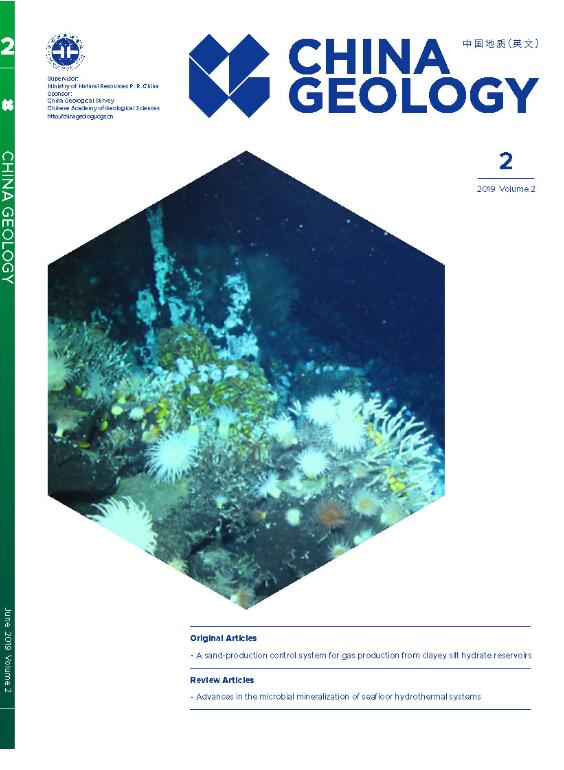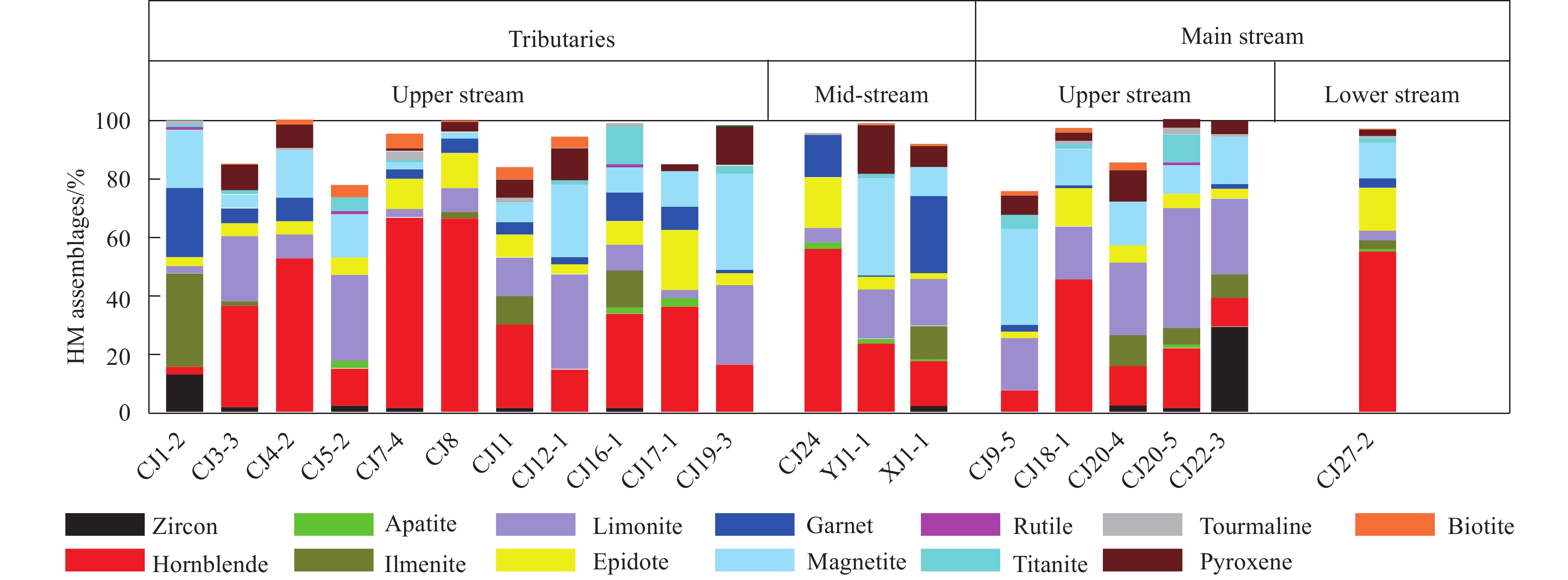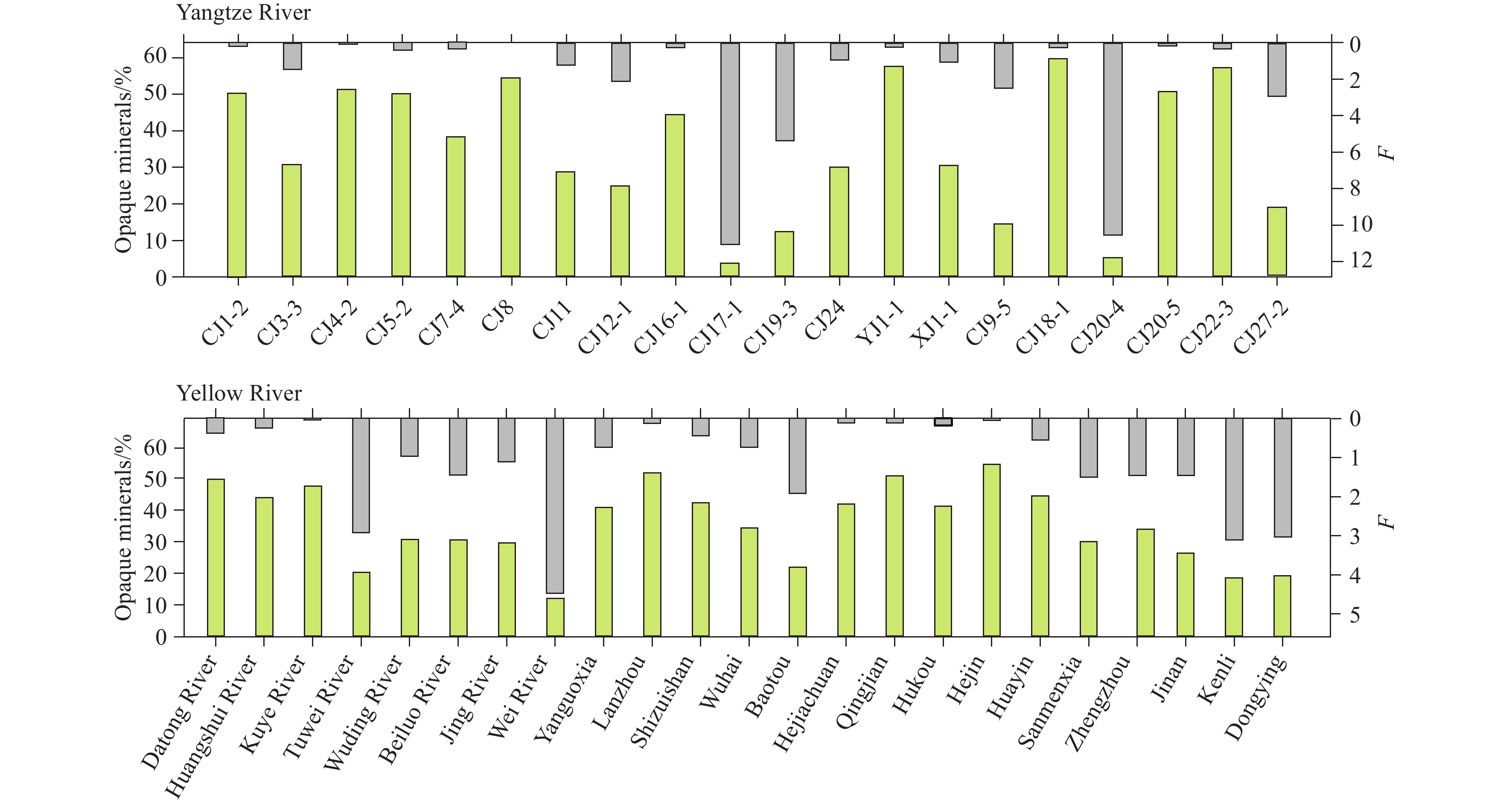| Citation: | Zhong-bo Wang, Ri-hui Li, Shou-ye Yang, Feng-long Bai, Xi Mei, Jian Zhang, Kai Lu, 2019. Comparison of detrital mineral compositions between stream sediments of the Yangtze River (Changjiang) and the Yellow River (Huanghe) and their provenance implication, China Geology, 2, 169-178. doi: 10.31035/cg2018065 |
Comparison of detrital mineral compositions between stream sediments of the Yangtze River (Changjiang) and the Yellow River (Huanghe) and their provenance implication
-
Abstract
A comparative comparative study on the detrital mineral composition of stream sediments of the Yangtze River (Changjiang) and Yellow River (Huanghe) shows that, light minerals of the Yangtze River basin were mainly quartz, feldspar, and detritus, the compositional characteristics of light minerals differed among tributaries, the main stream had a generally higher maturity index than tributaries; heavy mineral content tended to decrease progressively from the upper stream to lower stream of the Yangtze River, the primary assemblage was magnetite-hornblende-augite-garnet-epidote, and diagnostic minerals of different river basins were capable of indicating the nature and distribution of the source rock. Detrital mineral assemblages in sediments of tributaries and the main stream of the Yellow River were basically similar, Primary heavy mineral assemblage was opaque mineral-garnet-epidote-carbonate mineral and alteration mineral. Variations in the contents of garnet, opaque mineral, and hornblende mainly reflected the degree of sedimentary differentiation in suspended sediment and the hydrodynamic intensity of a drainage system. The heavy mineral differentiation index F revealed sedimentary differentiation of diagnostic detrital mineral composition due to changes in regional hydrodynamic intensity and can serve as an indicator for studying the dynamic sedimentary environment of a single-provenance river and the degree of sedimentary differentiation of its detrital minerals. Changes in detrital mineral content of the Yellow River was not completely controlled by provenance but reflected gravity sorting of the detrital mineral due to variations in the ephemeral river hydrodynamic intensity and sedimentary environment, however the index changing of Yangtze River were mainly influenced by the complex sediment sources. Therefore caution must be exercised in using the detrital mineral composition of marginal sea to determine the contribution of the Yangtze River and Yellow River.
-
Keywords:
- Yangtze River /
- Yellow River /
- Sediment /
- Detrital mineral /
- Provenance implication
-

-
References
[1] Chen LR. 1987. Geology of East China Sea. Beijing: Science Press, 33–57(in Chinese with English abstract). [2] Cheng TW, Zhao CN. 1985. Runoff volumes and sediment discharges of large rivers in China and their Influence on the coastal zone. Acta Oceanologica Sinica, 7(4), 460–471 (in Chinese with English abstract). [3] Dickinson WR, Valloni R. 1983. Provenance of North American Phanerozoic sandstones in relation to tectonics setting. Geological Science of America Bulletin, 94(2), 222–235. doi: 10.1130/0016-7606(1983)94<222:PONAPS>2.0.CO;2 [4] Hallsworth CR, Morton AC, Claoue LJ, Fanning CM. 2000. Carboniferous sand provenance in the Pennine Basin, UK: constraints from heavy mineral and detrital zircon age data. Sedimentary Geology, 137, 147–185. doi: 10.1016/S0037-0738(00)00153-6 [5] Jia JT, Zheng HB, Yang SY. 2010. Rock types in Yangtze drainage and their implication for zircon U–Pb provenance study of Yangtze sediments. Journal of Tongji University (Natural Sciences), 38(9), 1375–1381 (in Chinese with English abstract). [6] Lin XT, Li WR, Shi ZB. 2003. Characteristics of mineralogy in the clastic sediments from the Yellow River provenance, China. Marine Geology & Quaternary Geology, 23(3), 17–21 (in Chinese with English abstract). [7] Liu BJ. 1980. Sedimentary Petrology. Beijing: Geological Publishing House, 126 (in Chinese with English abstract). [8] Lu QR. 1992. Mineral characteristics of fine–grain dediment and its sedimentary differentiation in Changjiang estuary. Shanghai Geology, 43(3), 18–25 (in Chinese with English abstract). [9] Morton AC,Hallsworth CR. 1999. Processes controlling the composition of heavy mineral assemblages in sandstones. Sedimentary Geology, 124(1–4), 3–29. [10] Orman EF, Morad FL, Paul DK. 1995. Spatial variations in heavy minerals and patterns of sediment sorting along the Nile Delta, Egypt. Sedimentary Geology, 97, 22–41. [11] Pettijohn FJ, Potter PE, Siever R. 1977. Sand and Sandstone. Beijing: Science Press, 35–40. [12] Qu CH, Zhen JX. 1984. The study of the composition of suspended materials in the lower areas of Huanghe, Changjiang , Zhujiang and the restricted factors. Chinese Science Bulletin, 17, 1063–1066. [13] Rimington N, Cramp A, Morton AC. 2000. Amazon Fan sands: implication for provenance. Marine and Petroleum Geology, 17, 267–284. doi: 10.1016/S0264-8172(98)00080-4 [14] Schneiderman JS, Chen ZY. 2007. Interpretation of Quaternary tectonic and environmental change using heavy minerals of the Yangtze Delta plain. In: Maria AM, David TW, Eds, Developments in Sedimentology, 58, 607–620. [15] Singh BP, Pawar JS, Karlupia SK. 2004. Dense mineral data from the northwestern Himalayan foreland sedimentary rocks and recent river sediments: evaluation of the hinterland. Journal of Asian Earth Science, 23, 25–35. doi: 10.1016/S1367-9120(03)00097-X [16] Sun BY. 1990. Detrital mineral assemblages in the Huanghe, Changjiang and Zhujiang Delta sediments. Marine Geology & Quaternary Geology, 10(3), 23–34 (in Chinese with English abstract). [17] Vezzoli G, Garzanti E, Limonta M, Ando S, Yang SY. 2016. Erosion patterns in the Changjiang (Yangtze River) catchment revealed by bulk-sample versus single-mineral provenance budgets. Geomorphology, 261, 177–192. doi: 10.1016/j.geomorph.2016.02.031 [18] Wang LC, Chen XL, Chu TQ. 1997. A contrast analysis on the loads character of the Changjiang River and the Yellow River. Geographical Research, 16(4), 71–79 (in Chinese with English abstract). [19] Wang ZB, Yang SY, Li P, Li CX, Cai JG. 2006. Detrital mineral compositions of the Changjiang River sediments and their tracing implications. Acta Sedimentologica Sinica, 24(4), 570–578 (in Chinese with English abstract). [20] Wang ZB, Yang SY, Li RH, Zhang ZX, Li J, Bai FL, Li C. 2010. Detrital mineral composition of the sediments from Huanghe and its hydrodynamic environmental constraints. Marine Geology & Quaternary Geology, 30(4), 73–85 (in Chinese with English abstract). [21] Wang ZB, Yang SY, Mei X, Lu K. 2018. Detrital garnet chemistry of the Changjiang (Yangtze River) sediments and their provenance implication. Journal of Tongji University (Natural Sciences), 46(10), 1455–1461 (in Chinese with English abstract). [22] Wang ZY, Wang WL, Tian SM. 2007. Mineral composition and distribution of the sediment in the Yellow River basin. Journal of Sediment Research, 5, 1–8 (in Chinese with English abstract). [23] Xu JX, Hu CH, Chen JG. 2009. Effect of suspended sediment grain size on channel sedimentation in the lower Yellow River and some implications. Science in China (Earth Science), 39(2), 310–317. [24] Yang SY, Wang ZB, GuoY, Li CX. 2009. Heavy mineral compositions of the Changjiang (Yangtze River) sediments and their provenance–tracing implication. Journal of Asian Earth Sciences, 35(1), 56–65. doi: 10.1016/j.jseaes.2008.12.002 [25] Zhang OY, Xu JX. 2002. Decoupling of the Yellow River basin system. Geographical Research, 21(2), 188–194 (in Chinese with English abstract). -
Access History

-
Figure 1.
Lithology of the Yangtze River and the Yellow River drainage basins and sample locations (modified after Wang ZB et al., 2006, 2010 and Yang SY et al., 2009).
-
Figure 2.
Heavy mineral assemblages of the Yangtze River and its tributaries.
-
Figure 3.
Heavy mineral assemblages of the Yellow River and its tributaries (modified after Wang ZB et al. 2010).
-
Figure 4.
The opaqure mineral contents and their F of the Yangtze River and Yellow River sediments
-
Figure 5.
Correlation between the opaque minerals and hornblende of Yangtze River and Yellow River.





 DownLoad:
DownLoad:



